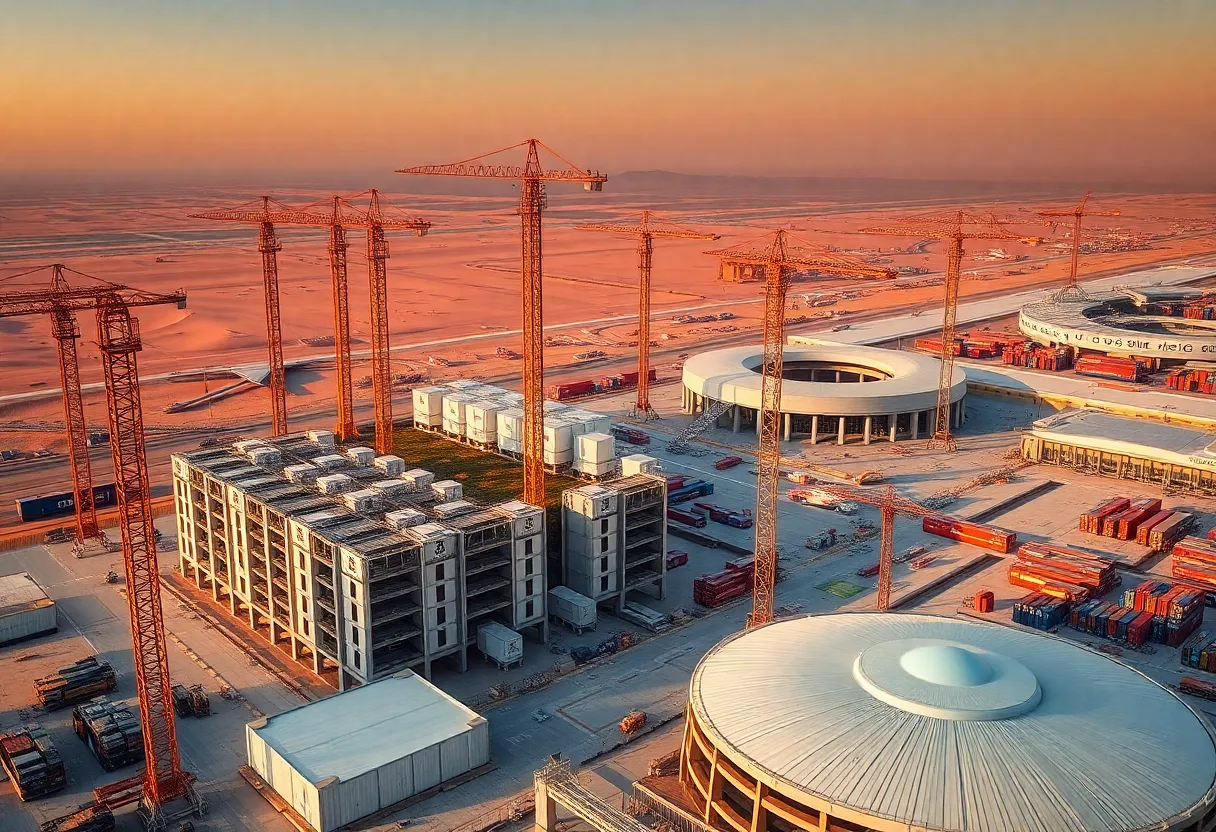Middle East, September 3, 2025
News Summary
The Middle East construction market reached USD 386.09 billion and is forecast to grow toward roughly USD 713 billion, propelled by large state plans, giga-projects and rapid urbanisation. Saudi Arabia and the UAE account for the largest market shares, while event-driven deadlines and tourism targets intensify demand for airports, hotels and stadiums. Expansion faces headwinds from foreign-worker caps, supply-chain disruptions, limited local materials capacity and climate-driven technical risks. Developers are scaling modular prefabrication, digital tools like BIM and PPP financing to meet fixed deadlines. Firms that combine modular methods, digital workflows and deeper local supply ties are best positioned to win work.
Middle East construction market set to nearly double by 2033 as giga‑projects and national plans drive demand
The Middle East construction market reached USD 386.09 billion in 2024 and is forecast to climb to USD 712.80 billion by 2033, growing at an annual rate of 7.05% (CAGR, 2025–2033). The outlook is powered by large state plans, major airport and stadium projects, a booming hotel pipeline, and a push toward greener, smarter cities. At the same time, labor shortages, supply‑chain delays and financing limits are constraining some activity.
Top‑line drivers and country shares
National transformation agendas are the main engine for construction spending across the region. Plans such as Saudi Vision 2030, UAE Centennial 2071 and Qatar National Vision 2030 prioritize urban growth, tourism and smart city development and are directly fueling demand for housing, transport and hospitality projects. Saudi Arabia led the region in 2024 with 39.3% market share, followed by the UAE with 28.3%.
Giga‑projects and event deadlines
State‑backed giga‑projects remain a central focus. Saudi authorities have allocated over USD 1.5 trillion to these schemes, including NEOM, a USD 500 billion development spanning 26,500 km² and featuring The Line, a 170‑km linear city. Event calendars also push delivery timetables: Riyadh will host several major events over the coming decade, and venues, transport and hospitality works are being prioritized to meet fixed deadlines.
Capital spending and corporate activity
Capital expenditure in Saudi construction reached SAR 178 billion (USD 47.5 billion) in 2023, a 22% year‑on‑year rise reported by the finance ministry. The region’s project pipeline includes major airport works—King Salman International Airport and Al‑Maktoum International among them—and a record hotel development pipeline with over 650 projects and 161,574 rooms in Q2 2025.
Constraints: labor, materials and finance
Growth is being limited by several practical issues. Labor shortages are acute after policy shifts such as a 30% cap on foreign workers per company in Saudi Arabia, which affected over 40% of local construction firms. Recruitment limits and disruptions in traditional labor flows from countries such as India, Bangladesh and the Philippines have caused delays. Worker welfare problems, including wage arrears and poor accommodation, have led to unrest in the sector.
Construction raw materials are mostly imported. Supply shocks have real effects—one shipping crisis in 2022 delayed 38% of material shipments to Saudi Arabia and Jordan and added about 45 days to lead times. Local manufacturing capacity is still limited; for example, there are only 12 integrated cement plants
Tech, modular building and sustainability
Off‑site methods and digital tools are gaining ground. Modular construction can cut on‑site labor needs by as much as 60% and reduce waste by about 35%, and several regional builders are investing in prefabrication hubs. One large modular residential complex was completed in 18 months, reportedly 40% faster than traditional methods.
Environmental rules and climate targets are shaping project design. Over 2,800 buildings in the UAE are registered under a Pearl rating system, Abu Dhabi now requires a minimum 2‑Pearl rating for new government buildings, and Saudi Arabia has introduced a Green Building Code that requires energy efficiency in public projects. Net‑zero urban pilots are under way in places such as Masdar City and Egypt’s New Administrative Capital.
Climate and durability issues
Harsh weather creates design and maintenance challenges. Coastal concrete is degrading faster due to salt and heat, with coastal areas experiencing about 40% faster degradation in some tests. Cooling accounts for nearly 70% of residential energy use in the region, and heat‑wave projections show a possible 20% increase in extreme heat days by 2050, raising risks for structures and occupants.
Market structure and competition
The construction landscape features national champions, global contractors and regional specialists competing for large, capital‑intensive projects. Market leaders include a mix of international groups and regional firms. Companies are differentiating with BIM and digital twins, off‑site construction, ESG compliance and faster delivery methods. The sector is also seeing consolidation, with stronger firms acquiring distressed rivals to boost capacity.
Equipment market and costs
The MENA construction equipment market was valued at USD 11.04 billion in 2024 and is projected to reach USD 13.81 billion by 2030 at a CAGR of 3.81%. Demand is driven by urban growth and industrial projects, though high purchase and maintenance costs, spare parts and training remain barriers.
Near‑term outlook
Despite a softer start to 2025—contract awards in the GCC fell 39% in the first five months compared with the same period in 2024—the region retains a robust pipeline. Authorities and firms are shifting to a delivery‑first approach, prioritizing projects tied to events and essential infrastructure. Financing constraints in some non‑GCC countries and currency pressures add unevenness, but sovereign funds and PPPs continue to underpin major programs.
What to watch
- Progress on NEOM and Saudi gigaprojects and how spending plans translate into contract awards.
- Labor policy and recruitment flows as limits on foreign workers are enforced and welfare measures evolve.
- Supply‑chain resilience and the growth of local prefabrication to ease material bottlenecks.
- Adoption of green codes and energy‑saving measures that will shape building design and costs.
FAQ
What is the current size of the Middle East construction market?
The market reached USD 386.09 billion in 2024 and is expected to grow to USD 712.80 billion by 2033.
What is driving the market growth?
Major national plans, large state gigaprojects, airport expansions, stadiums, and a record hotel development pipeline are the main drivers, along with sustainability and smart city programs.
Which countries lead the market?
Saudi Arabia led with about 39.3% market share in 2024, followed by the UAE with 28.3%.
What are the biggest constraints?
Labor shortages and caps on foreign workers, supply‑chain delays for imported materials, limited local manufacturing, and financing gaps in some non‑GCC countries are major constraints.
Are modular and off‑site methods being used?
Yes. Modular construction is gaining traction for speed, labor savings and waste reduction, and several regional firms are investing in prefabrication hubs.
How is climate affecting construction?
Extreme heat, salt‑laden air and humidity accelerate material degradation and raise cooling needs, pushing designers to adopt heat‑resilient materials and energy‑efficient systems.
What is the near‑term outlook?
Growth remains positive but uneven. The sector is shifting to prioritized delivery, focusing on event‑driven projects, airports, and critical infrastructure while managing labor and material constraints.
Key features at a glance
| Feature | Detail |
|---|---|
| 2024 market size | USD 386.09 billion |
| 2033 forecast | USD 712.80 billion |
| Forecast CAGR (2025–2033) | 7.05% |
| Top country (2024) | Saudi Arabia — 39.3% market share |
| Second largest (2024) | UAE — 28.3% market share |
| Major giga‑project (example) | NEOM — USD 500 billion; The Line 170 km; 26,500 km² |
| Key constraints | Labor caps, supply‑chain delays, limited local manufacturing, financing limits |
| Modular impact | Can reduce on‑site labor up to 60% and lower waste by ~35% |
| Construction equipment market (MENA) | USD 11.04 billion in 2024; projected USD 13.81 billion by 2030 (CAGR 3.81%) |
Deeper Dive: News & Info About This Topic
Additional Resources
- Market Data Forecast: Middle East Construction Market
- Wikipedia: Middle East construction market
- GlobeNewswire: Middle East & North Africa Construction Equipment Markets 2025-2030
- Google Search: Middle East construction equipment market 2025-2030
- World Construction Network: Middle East still offers large-scale construction opportunities
- Google Scholar: Middle East large-scale construction opportunities
- Hotel Business: LE — Middle East construction pipeline reaches record-high project count
- Encyclopedia Britannica: Middle East hotel development pipeline 2025
- CBNME: Optima OpenSpace bring 360° reality capture to Middle East projects
- Google News: 360 reality capture construction Middle East




